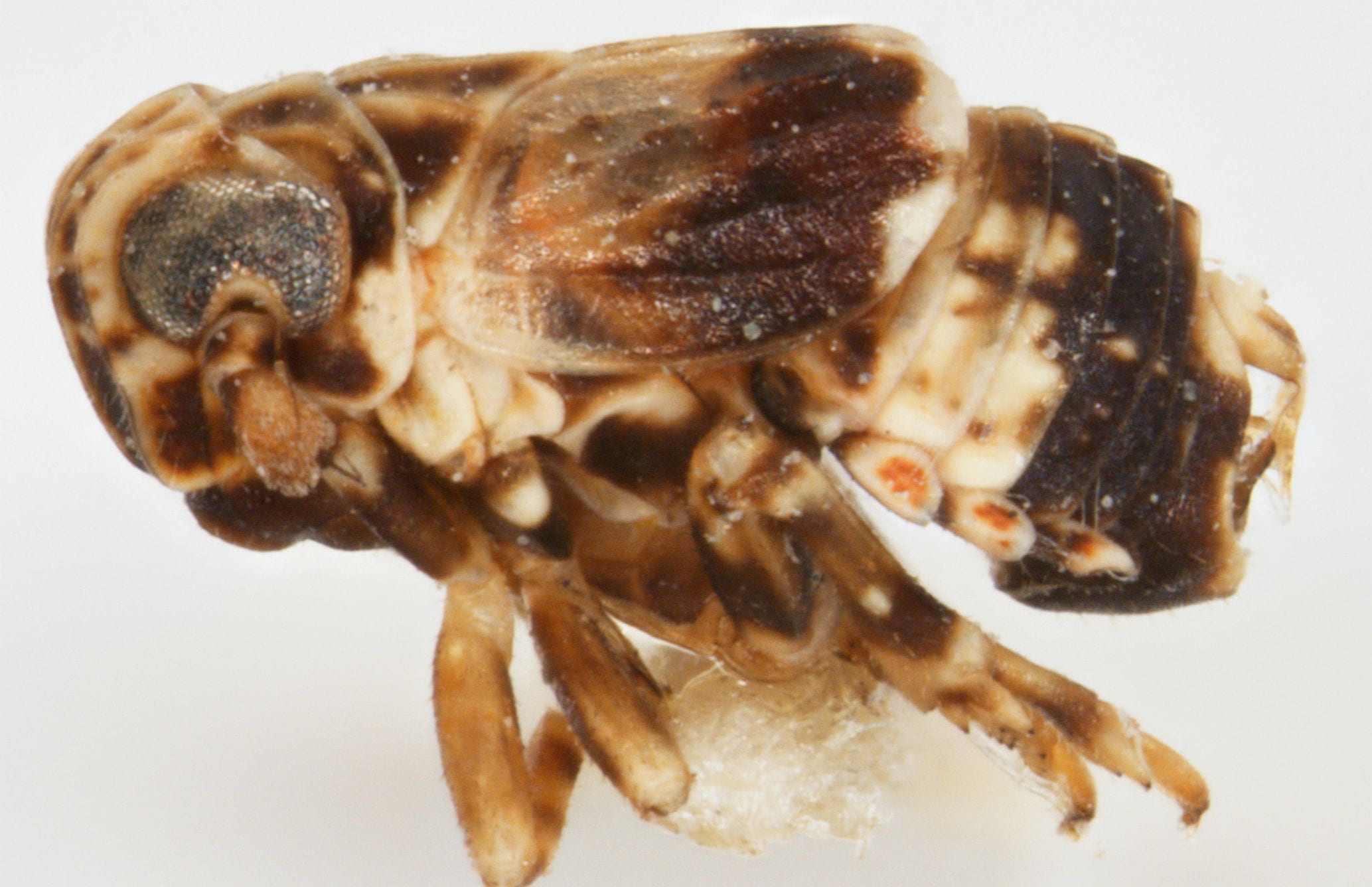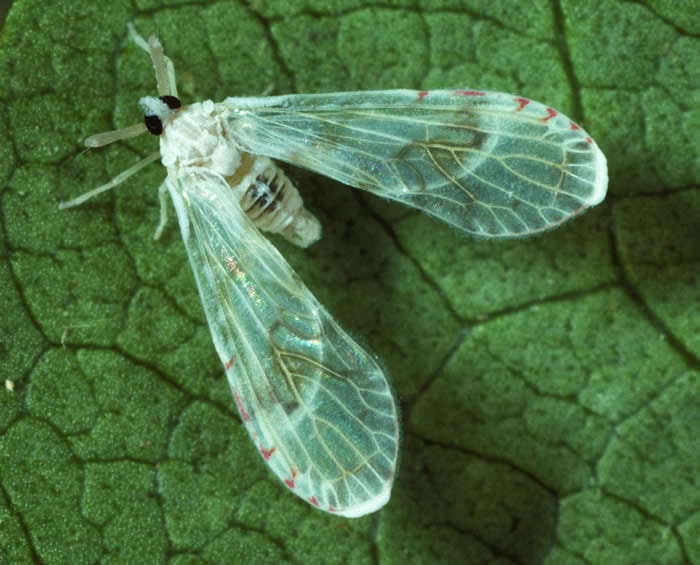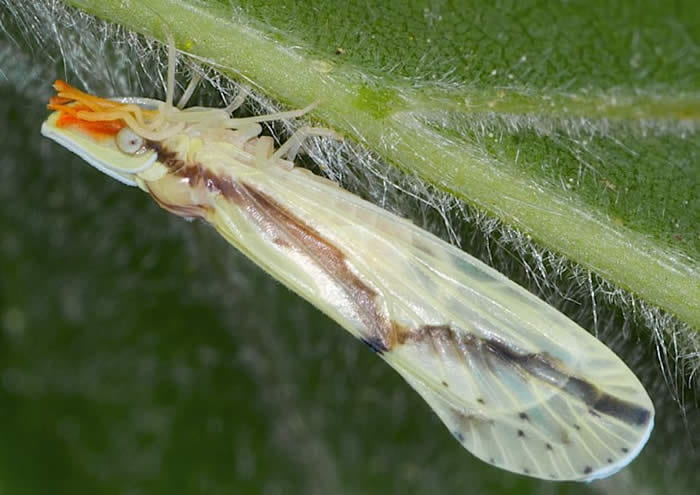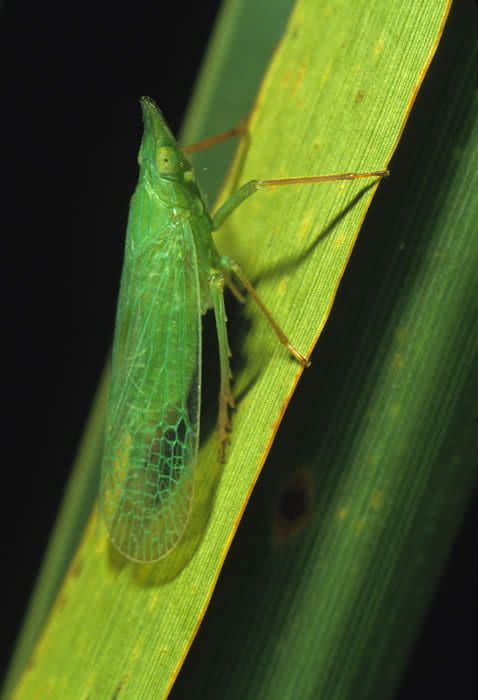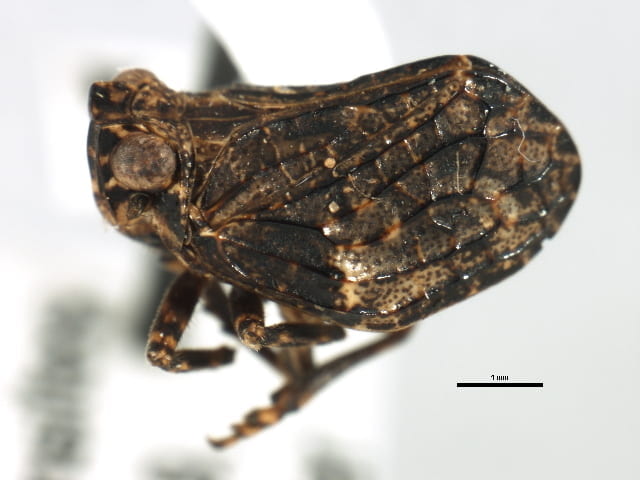There are 13 families of planthoppers currently recorded north of Mexico (2 others – Ricaniidae and Lophopidae – are found in the Neotropics, 6 more are Old World)

Acanalonia conica (Acanaloniidae); photo by Dave Funk of Stroud Water Research Center.
Acanaloniids are medium-sized, usually green (sometimes pink, although Philatis tuberculata from southern California is brown), wedge-shaped planthoppers that carry their broad wings parallel to the sides of their body. Acanaloniids are thought to be related to issids but are more often mistaken for flatid planthoppers which they superficially resemble. Acanaloniids are most easily found by sweeping or searching weedy or semi-perennial vegetation or by searching semi-woody herbs or shrubs (both adults and nymphs may be found this way). Acanaloniids feed on a variety of woody dicots particularly plants in the rose and aster families. There are 2 genera and 20 species of acanaloniids in the United States.
2. Achilidae

Dorsal view of Catonia nava (Achilidae).
Achilids are flattened, medium to small-sized planthoppers, generally with a brown or earth-toned color theme. They are most easily recognized by being rather flattened planthoppers with the wings overlapping over the end of the abdomen. There are 8 genera and 55 species north of Mexico, with the highest diversity in the southwest. Achilid planthoppers are thought to feed on fungal hyphae (as nymphs) and are sometimes found in rotting logs (both nymphs and adults). Adults evidently feed on a variety of woody plants and may be taken by beating woody vegetation; however, adults are most often found at lights (sometimes in large numbers), particularly in warm, humid weather in mid to late summer.

Habitus of Aphelonema rugosa (Caliscelidae).
4. Cixiidae
Dorsal and lateral view of Bothriocera cognita (Cixiidae) (scale = 0.5 mm).
Cixiids are medium to small planthoppers, most of which are somewhat flattened, with clear or patterned wings. Cixiidae may have a median ocellus (located on the face, just above the clypeus, when present). Among planthoppers, only cixiids and kinnarids have a median ocellus (some meenoplids as well). At least 15 genera and 178 species are in the US, with the highest diversity in the southwest (Cixiidae is the most diverse family of planthoppers worldwide, but North of Mexico there are more Delphacidae). As nymphs, cixiids are subterranean root-feeders (perhaps fungus) and are rarely observed. As adults, many species (particularly smaller forms) are associated with grasses or herbaceous monocots in rich, mesic or wet situations and may be found by sweeping (although Cixius is largely associated with pines) in mid to late summer or early fall. Some cixiids readily come to lights, particularly in warm, humid weather in mid-to-late summer, particularly in open woodlands or woodland edges, but may sit on vegetation near the light source instead of coming to the light. I have also found some of the larger cixiid species in mature woods resting on tree bark (particularly oaks with lichens), where they are cryptic. Some species are collected in Lindgren-funnel traps (which are usually intended for beetles)
5. Delphacidae
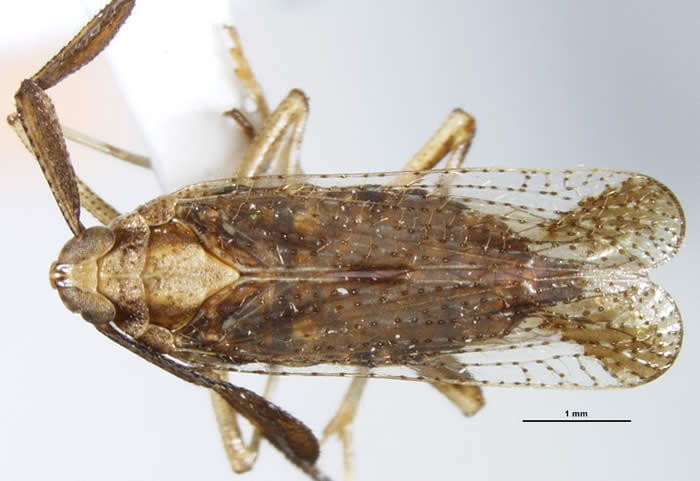
Dorsal view of Copicerus irroratus (Delphacidae) (scale = 0.5 mm).
Delphacids are small to tiny planthoppers represented by approximately 58 genera and 322 species in the United States (The most diverse family of planthoppers north of Mexico, but worldwide, Cixiidae are more diverse). As a family, they can be recognized by the apical spur on the hind leg. In the field, however, they appear quite similar to the more abundant leafhoppers. Delphacids can generally be separated from leafhoppers in the field by the relatively large antennae (compared to leafhoppers) that are visible on the sides of the head when looking from above. (Under a microscope, it can also be seen that leafhoppers have rows of spines and no spur on the femur of the hind leg.) Most delphacids feed on herbaceous monocots (grasses, sedges, rushes) in wet situations. A few are found in upland grasses. Two genera (Stobaera and Pissonotus) feed on composites. One species (Javesella opaca) has been found on the moss Polytrichum commune.
6. Derbidae
Like achilids, derbids are fungus feeders as immatures, and the nymphs are rarely observed. There are 14 genera and 67 species in the US. Many derbids are small, very fragile, and often bizarre appearing planthoppers with a narrow face, large antennae, and their wings much exceeding their body (sometimes held at angles from the body). However, the most commonly collected genus (Cedusa spp.) is a much less unusual appearing – wings deep grey and held tent-like, extending only a little beyond the abdomen. The key features of derbids are that the terminal segment of the beak is very short relative to the penultimate and there is often some modification of or near the antennae – either an antennal projection or a subtending “shelf” formed either by the antennae or the forward projecting lateral margin on the pronotum.
The most common and diverse genus of derbids (Cedusa) is often collected by seeping in herbaceous vegetation or at lights. Many of the more unusual forms are infrequently collected and can not be reliably found using any method, although malaise traps sometimes get good results and I have occasionally seen large numbers come to baited (CO2 and/or light) CDC mosquito traps.

Scolops sulcipes, Photo by Dave Funk of Stroud Water Resources Center.
Rhynchomitra microrhina (Dictyopharidae); ; Photo by Dave Funk of Stroud Water Research Center.
Dictyopharids are medium-sized planthoppers. Most dictyopharids can be recognized by having some sort of elongated head process. There are 14 genera and 80 species in the US, with most species in the southwest in the highly specialized subfamily Orgeriinae. There are relatively few species in the eastern United States, with most of them in the distinctive genus Scolops. Dictyopharids are mostly associated with woody or semiwoody vegetation. The common species Rhynchomitra microrhina is on wetland composits.
8. Flatidae
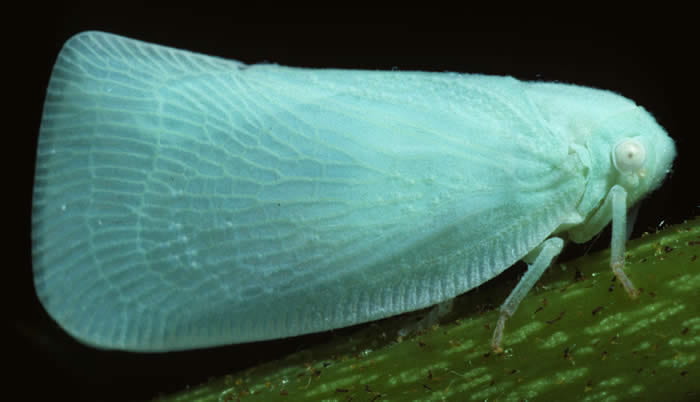
Flatormenis proxima (Flatinae: Nephesini); Photo by Dave Funk, Stroud Water Research Center (used by permission).
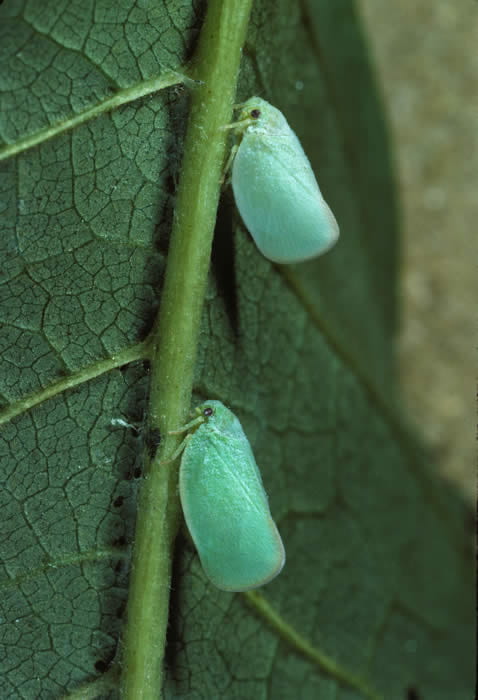
Ormenoides venusta (Flatinae, Nephesini); Photo by Dave Funk, Stroud Water Research Center (used by permission).
Metcalfa pruinosa (Flatidae); Photo by Dave Funk of Stroud Water Research Center
Flatids are primarily tropical and have the highest diversity in the southwest United States. Flatids are mostly feeders on trees, shrubs, and semi-woody perennials, particularly in open, sunny situations. Flatids are medium-sized planthoppers with broad wings held parallel to the body axis (like acanaloniids). Flatid nymphs produce abundant wax and are readily observed on plants.
Our common flatids and acanaloniids are easily confused. Generally, acanaloniids are more hard-bodied, have an entirely reticulate venation, and are not waxy as adults. Flatids are not nearly as hard-bodied, have one (or more) veins running parallel to the wing margin setting off a row (or two) or marginal cells, and have waxy wings (there are always waxy pustules in the claval region of the wing). In the United States, flatids are represented by 15 genera and 35 species, but 2 genera and 4 species are only known from very old, dubious records.
Metcalfa pruinosa – the citrus flatid planthopper – is adventive into Europe. A web page for the genus Metcalfa is here.
9. Fulgoridae

Dorsal view of Alphina glauca Calyptoproctus marmoratus (Fulgoridae) (scale = 2.0 mm).
The Fulgoridae (lanternflies) are medium to large planthoppers. Most members of the family are tropical, and tropical forms can be large and colorful (the genus Fulgora can be up to 3 inches long, but ours are mostly in the range of ½ – 1 inch). Generally, lanternflies feed on trees and shrubs, but some members of the genus Cyrpoptus have recently been found to be grass feeders (in the bases of some bunchgrasses). The family Fulgoridae is represented in the United States by only 10 genera and 18 species (one of which may be a taxonomic error), with most of these confined to the southwest.
Recently, the spotted lanternfly, Lycorma delicatula, has become adventive in Pennsylvania, now also reported in Virginia, New Jersey, New York, and Delaware, despite vigorous attempts at eradication in Pennsylvania.*
More recently Connecticut, Ohio, and West Virginia. (see map at Cornell extension here)
10. Issidae
Issid planthoppers (excluding the Nogodinidae and Caliscelidae) consist of only 2 genera and 10 species in the US, with most found in the southwest The Issidae in the strict sense are brown, medium-sized insects, that hold their wings weakly tent-like against the body, and generally have fully developed hind wings. Issids are the broadest near midlength and tend to be somewhat egg-shaped in outline when viewed from above. Issids are associated primarily with woody plants, for example Thionia bullata occurs on pines, Thionia ellipica on oaks, and Thionia simplex is polyphagous on dicots (I find it on black locust). Thionia does not usually come to lights and may be difficult to find by searching (but see Wheeler & Wilson 1987, 1988). The eastern issids come to Lindgren-funnel traps in wooded areas.
The Kinnaridae of the United States consists of 1 genus (Oeclidius) with 6 species (revised by Ball 1934), all from the southwestern states (although there are at least one undescribed species, probably representing a new genus. The Kinnaridae are similar to small Cixiidae in general appearance, and they share the row of spines on the second segment of the hind tarsus and may have a median ocellus near the frontoclypeal suture. Unlike cixiids, females have a reduced ovipositor and abdominal tergites 7-9 are “chevron-shaped” wax-producing plates. The nymphal habits and host biology of Kinnaridae are largely unknown. Kinnarids of Central and South America are poorly known (with many undescribed species), but those of the Caribbean were revised by Ramos (1957).
12. Nogodinidae
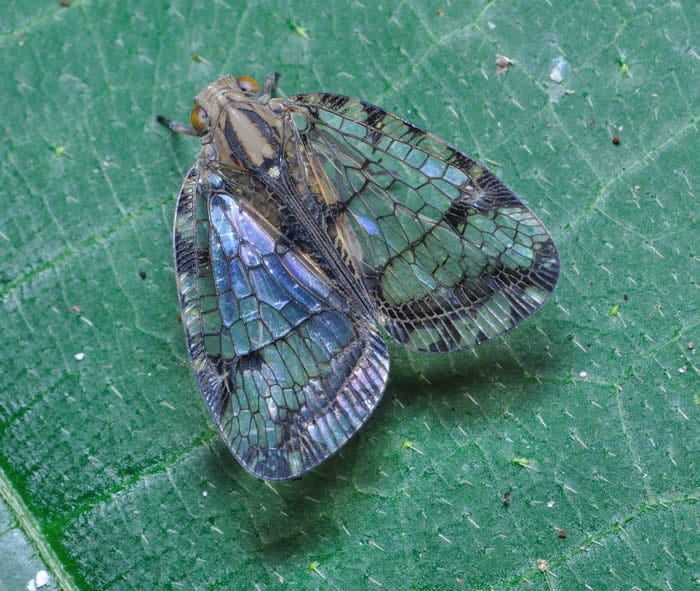
Nogodinidae from Tiskita Jungle Lodge in Costa Rica (Biolleyana sp. poss. costalis); photo by Brian Cutting, University of Delaware, Department of Entomology.
In North America, Nogodinidae is represented only by a single adventive species in the genus Colpoptera. Aside from Colpoptera, a series of genera known as the Gaetuliini (in North America, consisting of 10 genera in the southeastern United States) were moved from Issidae into Nogodinidae, but subsequently into the Tropiduchidae (where the tribe was subsumed under the Elicini of the subfamily Elicinae). As a Family, the Nogodinidae appear best defined based on features of the ovipositor. Most Nogodinidae have a reticulate wing venation (especially in brachypterous forms) and have clear patches on the wing; however, the family as currently comprised is polyphyletic (all family-level phylogenies with multiple representatives have failed to find a monophyletic family).
13. Tropiduchidae

Pelitropis rotulata (Tangiini) from North Carolina (photo by Kimberley Shropshire, University of Delaware, Department of Entomology)
Tropiduchids are mainly a tropical family with only 4 species in 4 genera in the southeastern US, 2 of which are doubtful records (reviewed by O’Brien 1992). The two species of traditional Tropiduchidae are Tangia breviceps and Pelitropis rotulata in the southeastern United States. Pelitropis rotulata is the most common and distributed throughout the southeastern US. It has been reported on 19 woody plants, including Myrica spp., and adults come to light. Tangia breviceps is found in southern Florida. Tropiduchids (in the usual sense) frequently have a distinctive wing venation – the front wings are macropterous and have a series of crossveins between costal margin and apex of clavus setting off a differentiated apical reticulate area.
In addition, there are a series of non-traditional Tropiduchidae that formerly belonged to Issidae (Gaetuliini), but have since been moved to The Tropiduchidae (Elicinae). Members of this group appear much like Issidae but bear reticulate wings with some clear patterning.


